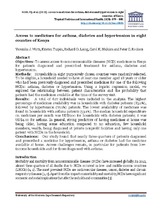Access to medicines for asthma, diabetes and hypertension in eight counties of Kenya
Date
2018Author
Wirtz, Veronika J.
Turpin, Kristen
Laing, Richard O.
Mukiira, Carol K.
Rockers, Peter C.
Metadata
Show full item recordAbstract
OBJECTIVES: To assess access to noncommunicable diseases (NCD) medicines in Kenya for patients diagnosed and prescribed treatment for asthma, diabetes and hypertension.
METHODS: Households in eight purposively chosen counties were randomly selected. To be eligible, a household needed to have at least one member aged 18 years or older who had been previously diagnosed and prescribed medicines for one of the following NCDs: asthma, diabetes or hypertension. Using a logistic regression model, we explored the relationship between patient characteristics and the probability that patients had the medicines available at the time of the survey visit.
RESULTS: A total of 627 individuals were included in the analysis. The highest percentage of medicines availability was in households with diabetes patients (83.1%), followed by hypertension (77.1%) patients. The lowest availability of medicines was found in households with asthma patients (53.1%). The median household expenditure on medicines per month was US$7.00 for households with diabetes patients; it was US$4.00 for asthma. In general, strong predictors of having medicines at home was being older, having some education compared to no education, few household members, wealth, being diagnosed at private nonprofit facilities and having only one patient with NCDs in the household.
CONCLUSIONS: Our study found that nearly three-quarters of patients diagnosed and prescribed a medicine for hypertension, asthma or diabetes had the medicine available at home. Access challenges remain, in particular for patients from low-income households and for those diagnosed with asthma.

